Photo Essay from South Asia (1)
Working Bovines in South Asia
Takashi Kurosaki
Last Revised August 27, 2001 (Japanese version: November 4, 1997)
India is known as a country with the largest number of cows and buffaloes in the world. The total number of all kinds of cattle and buffaloes well exceed 400 million. In other words, one sixth of the world's cows and one half of the world's buffaloes live in India. We find a similar picture in Pakistan with a higher population share of buffaloes than in India. Cattle and buffaloes, known as "bovines" as a group, number about 500 million in the two countries.
Because of this bovine population, it is no wonder that travellers find cows everywhere. So, let's go around rural South Asia focusing on cows and buffaloes.
In India, cows are regarded as "sacred" by Hindus. Cows symbolizes fertility and motherhood. Five products from cow, namely, milk, ghee (purified butter), yoghurt, urine, and dung, are used in religious purification.
In this essay, the economic value of cows will be explained, since I believe that their religious value is originally based on their economic value.
Bullock for Cultivation
The most important economic role of bovines was their work in cultivation. In semi-arid zones spanning India and Pakistan, land in the dry season becomes too hard. It is not possible to cultivate with hand plows. Therefore, to keep a pair of bullocks for work and for plowing was of vital importance to rural life.
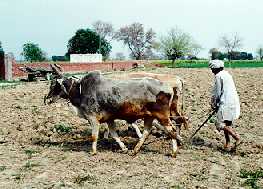 The picture left shows a Jat farmer ruling his bullocks to cultivate his land (Haryana, India, March 1995). The reason for worshipping cows in India could be due to the importance of cows in producing bullocks. Under traditional technologies, it was necessary for a prosperity of a farming family to have a healthy cow.
The picture left shows a Jat farmer ruling his bullocks to cultivate his land (Haryana, India, March 1995). The reason for worshipping cows in India could be due to the importance of cows in producing bullocks. Under traditional technologies, it was necessary for a prosperity of a farming family to have a healthy cow.
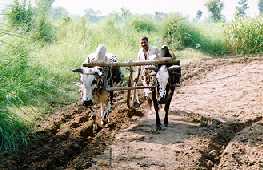 The picture rights shows a similar pair of bullock working in the field, but this time in Pakistan Punjab (1996). Even they are castrated, driving bullocks requires high skill. Plows are the key technology in South Asian agriculture. Because of this reason, many scholars are studying the shape of plows and the historical routes of technology transfers.
The picture rights shows a similar pair of bullock working in the field, but this time in Pakistan Punjab (1996). Even they are castrated, driving bullocks requires high skill. Plows are the key technology in South Asian agriculture. Because of this reason, many scholars are studying the shape of plows and the historical routes of technology transfers.
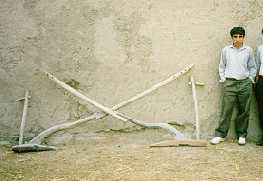 An example of a plow is shown in this picture taken in the same field in Pakistan (1993). The round shape of plow body is found widely in North-West India and Pakistan. If a family has a small holding just sufficient for subsistence, it usually has only one plow and only one pair of bullocks. On the other hand, a family with huge land holding has several plows. For this reason, the number of plows symbolizes the social status of a farming family in traditional villages of South Asia. For example, farmers contribute to village ceremonies according to their number of plows.
An example of a plow is shown in this picture taken in the same field in Pakistan (1993). The round shape of plow body is found widely in North-West India and Pakistan. If a family has a small holding just sufficient for subsistence, it usually has only one plow and only one pair of bullocks. On the other hand, a family with huge land holding has several plows. For this reason, the number of plows symbolizes the social status of a farming family in traditional villages of South Asia. For example, farmers contribute to village ceremonies according to their number of plows.
Bullock cultivation was once a rule in South Asia. Now tractor cultivation is replacing bullocks, although at a slower rate than observed elsewhere in the world.
Bullocks work not only in the field but also in other areas. They operate Persian wheel wells to irrigate land (Go to irrigation page), they give powers to fodder cutter, and they are the engine of bullock carts.
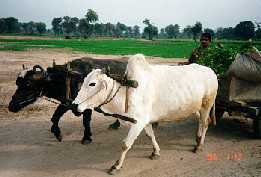 This photo (left) was taken in my field of Shekhupura, Punjab, Pakistan. This is indeed a rare one. Can you guess why?
This photo (left) was taken in my field of Shekhupura, Punjab, Pakistan. This is indeed a rare one. Can you guess why?
The white animal on the front is a bullock of Indian Zebu cattle, while the black animal behind is a he-buffalo. In North India and Pakistan, buffaloes are kept mainly for milk. He-buffaloes are stubborn and rarely used for work. The bullock of Indian Zebu belongs to a Gaajar variety which is known as one of the best cattle breeds for work on the Subcontinent.
You may wonder if it is correct to say that buffaloes are not used much for work. Indeed, he-buffaloes are the main working animals in South-East Asia and South China. Actually, there are two types of buffaloes. One is "river" type, which is raised in Pakistan, North India, and Brazil. The other is "swamp" type, which is found in South-East Asia and South China (and even in Okinawa, Japan). The river type buffaloes have a large body and best for producing milk; the swamp type buffaloes are smaller and best as working animals. There is also a "savanna" type buffaloes, indigenous to Africa.
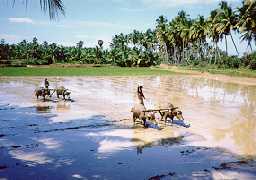 In this photo (left), two pairs of swamp type buffaloes are working in paddy fields. The photo was taken in Tamil Nadu, South India. Let's zoom up a little bit...
In this photo (left), two pairs of swamp type buffaloes are working in paddy fields. The photo was taken in Tamil Nadu, South India. Let's zoom up a little bit...
 As you can see from the size of the driving farmer, swamp type buffaloes have small body, big head, authoritative horns, and long legs. As you can see from the picture before, river type buffaloes have a small, round horns.
As you can see from the size of the driving farmer, swamp type buffaloes have small body, big head, authoritative horns, and long legs. As you can see from the picture before, river type buffaloes have a small, round horns.
Milch Animals
As tractors become popular, the economic value of working bovines goes down and that of milch animals goes up. One reason for this change is that demand for milk is rapidly going up as general living standards are improved in South Asia. The importance of livestock products in diets goes up everywhere on the globe as the economic growth occurs. But in the case of India, rising demand goes to milk and milk products, not to meat, due to the vegetarian tradition.
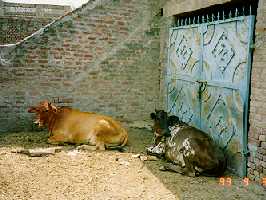 This photo was taken in my survey village in Pakistan Punjab in 1993. The best breeds for milk in the village are shown. The brown cow on the left belongs to Sahiwal variety. It is known as the best milking cows in Punjab. The spotted cow on the right is a cross-breed between Sahiwal and Holstein-Friesien from Europe. European breeds for milking have difficulty in adjusting to the weather in South Asia. The cross-breed is a rare case of success.
This photo was taken in my survey village in Pakistan Punjab in 1993. The best breeds for milk in the village are shown. The brown cow on the left belongs to Sahiwal variety. It is known as the best milking cows in Punjab. The spotted cow on the right is a cross-breed between Sahiwal and Holstein-Friesien from Europe. European breeds for milking have difficulty in adjusting to the weather in South Asia. The cross-breed is a rare case of success.
In India also, many attempts have been made to produce good varieties of cross-breeds. The rapid increase in milk production that occurred in India and Pakistan in the 1980s is called "White Revolution," in the same line with "Green Revolution" of rice and wheat in the 1960-70s.
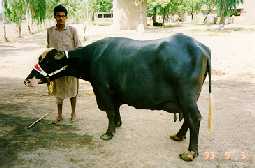 Although it is true that the output of cow milk is going up rapidly, a more rapid increase has been observed in buffalo milk production. About 60% of milk production in India and more than three fourth of milk production in Pakistan come from she-buffaloes. The photo shows a prize-winning she-buffalo. I took this photo in the livestock experimental institute in Okara, Pakistan's Punjab, 1993. The animal belongs to a Nili-Ravi variety, known as the best milking animal in Pakistan. It not only produces three or four times the amount of milk an average cow produces, but also its milk has 8% fat content. Best for producing butter. Because of the high fat contents, buffalo milk is sold at premium price.
Although it is true that the output of cow milk is going up rapidly, a more rapid increase has been observed in buffalo milk production. About 60% of milk production in India and more than three fourth of milk production in Pakistan come from she-buffaloes. The photo shows a prize-winning she-buffalo. I took this photo in the livestock experimental institute in Okara, Pakistan's Punjab, 1993. The animal belongs to a Nili-Ravi variety, known as the best milking animal in Pakistan. It not only produces three or four times the amount of milk an average cow produces, but also its milk has 8% fat content. Best for producing butter. Because of the high fat contents, buffalo milk is sold at premium price.
Because of the spread of tractors, the role of cows in giving birth to bullocks has become less important. Then she-buffaloes are becoming more important as milk animals than cows because buffaloes are relatively more efficient in producing milk. The shift from cows to buffaloes is found in official statistics as well.
However, she-buffaloes are different from cows in one important sense in India. She-buffaloes are not regarded sacred by Hindus.
 One important feature in rural Punjab today is the increased production of milk/dairy products. Rural producers are connected to town consumers through this kind of milkman (called Dodhi), who collects milk every morning from small milk producers and brings it to the town by a bicycle. The photo shows such a milk man working in a chilly, early morning in winter time (Photo: January 1996, Sheikhupura, Punjab, Pakistan).
One important feature in rural Punjab today is the increased production of milk/dairy products. Rural producers are connected to town consumers through this kind of milkman (called Dodhi), who collects milk every morning from small milk producers and brings it to the town by a bicycle. The photo shows such a milk man working in a chilly, early morning in winter time (Photo: January 1996, Sheikhupura, Punjab, Pakistan).
Animals for Dung
Finally, one important role of bovine animals in rural South Asia is dung production. Cattle/buffalo dungs are mixed with straws, shaped into round disks, and dried. The cow dung thus made is used as fuel (it is called "cow dung" regardless of the actual type of bovines that produce the dung). In most of rural villages in South Asia, cow dung is the most important fuel source.
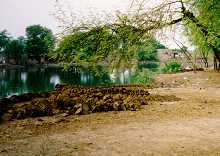 In this photo, you can see cow dungs dried in the sun. Cow dungs put on the walls create an interesting pattern that forms a rural picture. Cow dungs are also sold and purchased regularly in village markets.
In this photo, you can see cow dungs dried in the sun. Cow dungs put on the walls create an interesting pattern that forms a rural picture. Cow dungs are also sold and purchased regularly in village markets.
Previously, cow dungs were also used in producing farm yard manure. The spread of chemical fertilizer reduced the importance of cow dungs in this sphere. However, too much dependence on chemical fertilizer degrades the land quality in the long run. Land needs organic fertilizer from farm yard manure. How to make a balance between the two uses of cow dungs is an important problem to solve for a sustainable rural life in South Asia.
Reference:
Kurosaki, Takashi (1998) Risk and Household Behavior in Pakistan's Agriculture, Tokyo: Institute of Developing Economies.
Mishra, S. N., and R. K. Sharma (1990) Livestock Development in India: An Appraisal, New Delhi: Vikas.
Vaidyanathan, A. (1988) Bovine Economy in India, Trivandrum: Centre for Development Studies.
Back to Mariamma's Homepage (Information on South Asia): HOME; English Index
Back to Tak's University Homepage
 The picture left shows a Jat farmer ruling his bullocks to cultivate his land (Haryana, India, March 1995). The reason for worshipping cows in India could be due to the importance of cows in producing bullocks. Under traditional technologies, it was necessary for a prosperity of a farming family to have a healthy cow.
The picture left shows a Jat farmer ruling his bullocks to cultivate his land (Haryana, India, March 1995). The reason for worshipping cows in India could be due to the importance of cows in producing bullocks. Under traditional technologies, it was necessary for a prosperity of a farming family to have a healthy cow. The picture rights shows a similar pair of bullock working in the field, but this time in Pakistan Punjab (1996). Even they are castrated, driving bullocks requires high skill. Plows are the key technology in South Asian agriculture. Because of this reason, many scholars are studying the shape of plows and the historical routes of technology transfers.
The picture rights shows a similar pair of bullock working in the field, but this time in Pakistan Punjab (1996). Even they are castrated, driving bullocks requires high skill. Plows are the key technology in South Asian agriculture. Because of this reason, many scholars are studying the shape of plows and the historical routes of technology transfers. An example of a plow is shown in this picture taken in the same field in Pakistan (1993). The round shape of plow body is found widely in North-West India and Pakistan. If a family has a small holding just sufficient for subsistence, it usually has only one plow and only one pair of bullocks. On the other hand, a family with huge land holding has several plows. For this reason, the number of plows symbolizes the social status of a farming family in traditional villages of South Asia. For example, farmers contribute to village ceremonies according to their number of plows.
An example of a plow is shown in this picture taken in the same field in Pakistan (1993). The round shape of plow body is found widely in North-West India and Pakistan. If a family has a small holding just sufficient for subsistence, it usually has only one plow and only one pair of bullocks. On the other hand, a family with huge land holding has several plows. For this reason, the number of plows symbolizes the social status of a farming family in traditional villages of South Asia. For example, farmers contribute to village ceremonies according to their number of plows. This photo (left) was taken in my field of Shekhupura, Punjab, Pakistan. This is indeed a rare one. Can you guess why?
This photo (left) was taken in my field of Shekhupura, Punjab, Pakistan. This is indeed a rare one. Can you guess why? In this photo (left), two pairs of swamp type buffaloes are working in paddy fields. The photo was taken in Tamil Nadu, South India. Let's zoom up a little bit...
In this photo (left), two pairs of swamp type buffaloes are working in paddy fields. The photo was taken in Tamil Nadu, South India. Let's zoom up a little bit... As you can see from the size of the driving farmer, swamp type buffaloes have small body, big head, authoritative horns, and long legs. As you can see from the picture before, river type buffaloes have a small, round horns.
As you can see from the size of the driving farmer, swamp type buffaloes have small body, big head, authoritative horns, and long legs. As you can see from the picture before, river type buffaloes have a small, round horns. This photo was taken in my survey village in Pakistan Punjab in 1993. The best breeds for milk in the village are shown. The brown cow on the left belongs to Sahiwal variety. It is known as the best milking cows in Punjab. The spotted cow on the right is a cross-breed between Sahiwal and Holstein-Friesien from Europe. European breeds for milking have difficulty in adjusting to the weather in South Asia. The cross-breed is a rare case of success.
This photo was taken in my survey village in Pakistan Punjab in 1993. The best breeds for milk in the village are shown. The brown cow on the left belongs to Sahiwal variety. It is known as the best milking cows in Punjab. The spotted cow on the right is a cross-breed between Sahiwal and Holstein-Friesien from Europe. European breeds for milking have difficulty in adjusting to the weather in South Asia. The cross-breed is a rare case of success. Although it is true that the output of cow milk is going up rapidly, a more rapid increase has been observed in buffalo milk production. About 60% of milk production in India and more than three fourth of milk production in Pakistan come from she-buffaloes. The photo shows a prize-winning she-buffalo. I took this photo in the livestock experimental institute in Okara, Pakistan's Punjab, 1993. The animal belongs to a Nili-Ravi variety, known as the best milking animal in Pakistan. It not only produces three or four times the amount of milk an average cow produces, but also its milk has 8% fat content. Best for producing butter. Because of the high fat contents, buffalo milk is sold at premium price.
Although it is true that the output of cow milk is going up rapidly, a more rapid increase has been observed in buffalo milk production. About 60% of milk production in India and more than three fourth of milk production in Pakistan come from she-buffaloes. The photo shows a prize-winning she-buffalo. I took this photo in the livestock experimental institute in Okara, Pakistan's Punjab, 1993. The animal belongs to a Nili-Ravi variety, known as the best milking animal in Pakistan. It not only produces three or four times the amount of milk an average cow produces, but also its milk has 8% fat content. Best for producing butter. Because of the high fat contents, buffalo milk is sold at premium price. One important feature in rural Punjab today is the increased production of milk/dairy products. Rural producers are connected to town consumers through this kind of milkman (called Dodhi), who collects milk every morning from small milk producers and brings it to the town by a bicycle. The photo shows such a milk man working in a chilly, early morning in winter time (Photo: January 1996, Sheikhupura, Punjab, Pakistan).
One important feature in rural Punjab today is the increased production of milk/dairy products. Rural producers are connected to town consumers through this kind of milkman (called Dodhi), who collects milk every morning from small milk producers and brings it to the town by a bicycle. The photo shows such a milk man working in a chilly, early morning in winter time (Photo: January 1996, Sheikhupura, Punjab, Pakistan). In this photo, you can see cow dungs dried in the sun. Cow dungs put on the walls create an interesting pattern that forms a rural picture. Cow dungs are also sold and purchased regularly in village markets.
In this photo, you can see cow dungs dried in the sun. Cow dungs put on the walls create an interesting pattern that forms a rural picture. Cow dungs are also sold and purchased regularly in village markets.